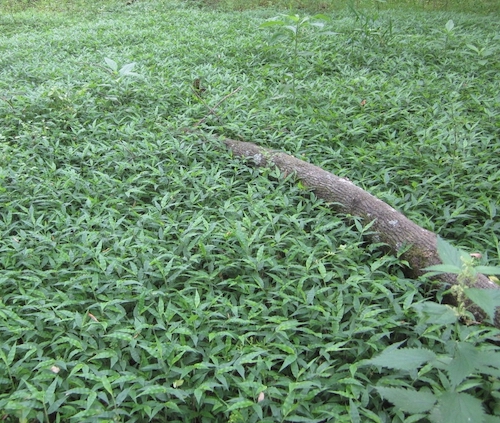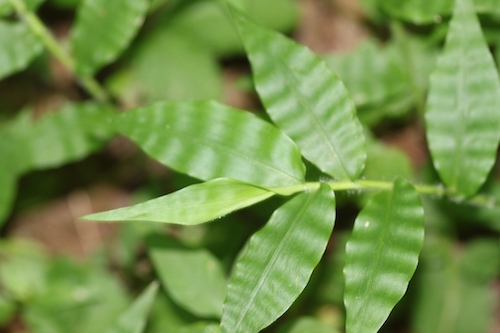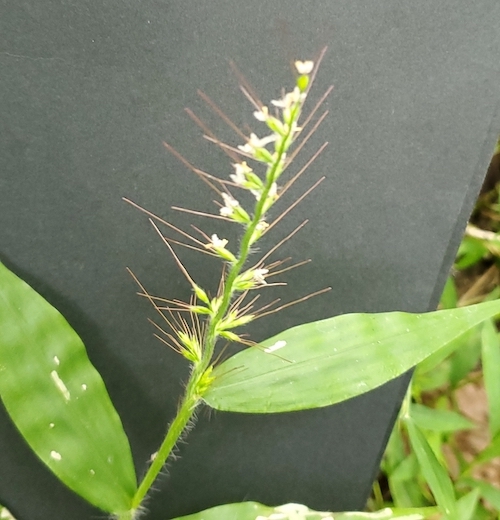Wavyleaf Basketgrass, Another Invasive Species
by Nancy Miller, Fairfax Master Gardener

Wavyleaf basketgrass covers the ground
We have an invasive species that you may not know about: wavyleaf basketgrass. Oplismenus undulatifolius is native to southeast Asia, Australia and southern Africa. A member of the grass family (Poaceae), it is a low-growing perennial with shallow roots. Its deep green leaves, 1/2 inch wide x 4 inches long, have telltale undulating ripples across the surface. The leaf sheath and stem are particularly hairy with short hairs. In the fall, it will produce small, wispy white or purple flowers at the end of its branches. Its seeds grow in 3 to 5 pairs of spikelets with long awns (pointed tips) that produce a sticky substance to aid in seed dispersal. It can also spread quickly through its shallow rhizomes. It is recognized as a US Department of Agriculture high-risk invasive species.
O. undulatifolius appeared in Maryland’s Patapsco State Park in 1996 (probably from a discarded floral arrangement), then in Shenandoah National Park in 2005. By 2023, there were 60 known sites in more than 20 counties in Virginia, and over 15 counties in Maryland. Surrounding states, including North Carolina, Pennsylvania and New York, have also declared wavyleaf basketgrass to be invasive. It is spreading north and west.

Identifying wavy leaf closeup
Found primarily in shaded, mesic deciduous forests, it quickly spreads to completely cover the forest floor, displacing native plants and suppressing the growth of shrub and tree seedlings. Wavyleaf basketgrass enjoys the same habitat as Japanese stiltgrass — and has even been found growing under the stiltgrass. Unfortunately, as typical exotic invasives, neither provides nutritional value for native wildlife.
There are two native subspecies of basketgrass (Oplismenus hirtellus ssp. fasciculatus) and (O. hirtellus ssp. setarius). found in the southern and southeastern United States, but not in the Mid-Atlantic. Native deer-tongue panicgrass and small carpetgrass resemble wavyleaf and do grow in the Mid-Atlantic. However, both grow in upright clumps and do not have rippled leaves. Japanese stiltgrass has hairs that form a silver-colored line down the midrib of the leaf blade, and its leaves are not rippled.
Controlling the spread of wavyleaf basketgrass is not difficult for small patches because it has a shallow root system. Hand pulling will suffice if seeds are removed, sealed in a container and disposed of in a landfill. Large infestations require post-emergent chemical treatment in spring or summer prior to flowering. It often takes three years or more to eradicate large colonies.

Seed head
The real challenge to stopping the spread of wavyleaf basketgrass is preventing its seed dispersal. The sticky substance produced by the awns means the seeds stick to animal fur, clothing, shoes, tires and anything else that the awns touch. Some evidence points to hikers’ involvement in the seed spread. If you are exposed to wavyleaf, it is most important to use sticky tape to remove the seeds before leaving the site. (Don’t forget the soles of your shoes/boots!) You can report infestations iNaturalist.
Some native alternatives are wild ginger (Asarum canadense), Carolina Green-and-gold (Chrysogonum repens), Green-and-gold (Chrysogonum virginianum), Native Stonecrop (Sedum ternatum) and Foamflower (Tiarella cordifolia). Your local native plant society can also recommend native grasses.
-
References
- Wavyleaf Basketgrass A New Forest Invader in Maryland, Maryland Department of Natural Resources
- Invasive Plant Alert: Wavyleaf Grass (Oplismenus undulatifolius), Virginia Department of Conservation and Recreation, Division of Natural Heritage
- Wavyleaf Basketgrass, West New York PRISM
- Oplismenus undulatifolius, North Carolina Extension